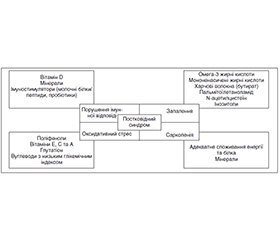Список литературы
1. AAP, AACAP, CHA declare national emergency in children’s mental health. https://publications.aap.org/aapnews/news/17718.
2. Aiyegbusi OL, Hughes SE, Turner G, Rivera SC, McMullan C, Chandan JS, et al. (2021). Symptoms, complications and management of long COVID: a review. Journal of the Royal Society of Medicine. 114 (9): 428-442. doi: 10.1177/01410768211032850.
3. Altmann DM, Whettlock EM, Liu S, Arachchillage DJ, Boyton RJ (July 2023). The immunology of long COVID. Nature Reviews. Immuno–logy. 23 (10): 618-634. doi: 10.1038/s41577-023-00904-7.
4. Alkodaymi MS, Omrani OA, Fawzy NA, Shaar BA, Almamlouk R, Riaz M, et al. (2022). Prevalence of post-acute COVID-19 syndrome symptoms at different follow-up periods: a systematic review and meta-analysis. Clinical Microbiology and Infection. 28 (5): 657-666. doi: 10.1016/j.cmi.2022.01.014.
5. Astin R, Banerjee A, Baker MR, Dani M, Ford E, Hull JH, et al. (2023). Long COVID: mechanisms, risk factors and recovery. Experimental Physiology. 108 (1): 12-27. doi: 10.1113/EP090802.
6. Barrea L, Grant WG, Frias-Toral E, Vetrani C, Verde L, de Alteriis G, et al. (2022) Dietary Recommendations for Post-COVID-19 Syndrome. Nutrients. 14(6): 1305; https://doi.org/10.3390/nu14061305.
7. Beketova GV, Horiacheva IP, Volosovets AA, Mozgova GP, Beketova NV (2022). Рsychological characteristics of children and adolescents who have undergone COVID-19: possibilities of correction. Pediatrics. Eastern Europe. 1. 10: 145-160. doi: 10.34883/PI.2022.10.1.019.
8. Brodin P (2021). Immune determinants of COVID-19 disease presentation and severity. Nature Medicine. 27 (1): 28-33. doi: 10.1038/s41591-020-01202-8.
9. Buonsenso D (2023). Pharmacological trials for long COVID: first light at the end of the tunnel The Lancet. Regional Health — Europe. 24: 100544. doi: 10.1016/j.lanepe.2022.100544.
10. Byambasuren O, Stehlik P, Clark J, Alcorn K, Glasziou P (2023). Effect of COVID-19 vaccination on long covid: systematic review. BMJ Medicine. 2 (1): e000385. doi: 10.1136/bmjmed-2022-000385.
11. Centers for Disease Control and Prevention, US Department of Health and Human Services. 2023-07-20. Archived from the original on 2022-01-14. Retrieved 2023-07-23.
12. Centers for Disease Control and Prevention. 2022-12-16. Archived from the original on 2023-08-12. Retrieved 2023-08-10.
13. Chen C, Haupert SR, Zimmermann L, Shi X, Fritsche LG, Mukherjee B (November 2022). Global Prevalence of Post-Coronavirus Disease 2019 (COVID-19) Condition or Long COVID: A Meta-Analysis and Systematic Review. The Journal of Infectious Diseases. 226 (9): 1593-1607. doi: 10.1093/infdis/jiac136.
14. Chen B, Julg B, Mohandas S, Bradfute SB (May 2023). Viral persistence, reactivation, and mechanisms of long COVID. eLife. 12. doi: 10.7554/eLife.86015.
15. COVID-19 rapid guideline: managing the long-term effects of –COVID-19. National Institute for Health and Care Excellence. 2021-11-11. Р. 5. Archived from the original on 2023-08-02. Retrieved 2023-09-09.
16. Davis HE, McCorkell L, Vogel JM, Topol EJ (March 2023). Long COVID: major findings, mechanisms and recommendations. Nature Reviews. Microbiology. 21 (3): 133-146. doi: 10.1038/s41579-022-00846-2.
17. Evaluating and Caring for Patients with Post-COVID Conditions: Interim Guidance. https://www.cdc.gov/coronavirus/2019-ncov/hcp/clinical-care/post-covid-index.html.
18. Ford ND, Slaughter D, Edwards D, Dalton A, Perrine C, Vahratian A, et al. (2023). Long COVID and Significant Activity Limitation Among Adults, by Age — United States, June 1–13, 2022, to June 7–19, 2023. MMWR. Morbidity and Mortality Weekly Report. 72 (32): 866-870. doi: 10.15585/mmwr.mm7232a3.
19. Hastie CE, Lowe DJ, McAuley A, Winter AJ, Mills NL, Black C, et al. (2022). Outcomes among confirmed cases and a matched comparison group in the Long-COVID in Scotland study. Nature Communications. 13 (1): 5663. Bibcode:2022.NatCo..13.5663H. doi: 10.1038/s41467-022-33415-5.
20. Jiang L, Li X, Nie J, Tang K, Bhutta ZA (2023). A Systematic Review of Persistent Clinical Features After SARS-CoV-2 in the Pediatric Population. Pediatrics. 152 (2). doi: 10.1542/peds.2022-060351.
21. Kozlov M (2023). NIH launches trials for long COVID treatments: what scientists think. Nature. doi: 10.1038/d41586-023-02472-1.
22. Ledford H (2022). How common is long COVID? Why stu–dies give different answers. Nature. 606 (7916): 852-853. Bibcode: 2022Natur.606..852L. doi: 10.1038/d41586-022-01702-2.
23. Long COVID: fatigue predicts poor everyday functioning. UK National Institute for Health and Care Research. 2023-11-23. doi: 10.3310/nihrevidence_60359. Archived from the original on 2023-12-04. Retrieved 2023-12-04.
24. Messiah SE, Francis J, Weerakoon S, Mathew MS, Shaikh S, Veeraswamy A, et al. (2023). Persistent symptoms and conditions among children and adolescents hospitalised with COVID-19 illness: a qualitative study. BMJ Open. 13 (9): e069073. doi: 10.1136/bmjopen-2022-069073.
25. NIH launches new initiative to study Long COVID. National Institutes of Health (NIH). 2021. Archived from the original on 2021-05-13. Retrieved 2021-02.
26. Proal AD, Vanelzakker MB (2021). Long COVID or Post-acute Sequelae of COVID-19 (PASC): An overview of biological factors that may contribute to persistent symptoms. Frontiers in Microbiology. 12. doi: 10.3389/fmicb.2021.698169.
27. Rao S, Gross RS, Mohandas S, Stein CR, et al. (2024). Postacute Sequelae of SARS-CoV-2 in Children. Pediatrics. 153 (3). doi: 10.1542/peds.2023-062570.
28. Stefanou MI, Palaiodimou L, Bakola E, Smyrnis N, Papadopoulou M, Paraskevas GP, et al. (2022). Neurological manifestations of long-COVID syndrome: a narrative review. Therapeutic Advances in Chronic Disease. 13: 20406223221076890. doi: 10.1177/20406223221076890.
29. Soriano JB, Murthy S, Marshall JC, Relan P, Diaz JV (2022). A clinical case definition of post-COVID-19 condition by a Delphi consensus. The Lancet. Infectious Diseases. 22 (4): e102–e107. doi: 10.1016/S1473-3099(21)00703-9.
30. Subbaraman N (2021). US health agency will invest $1 billion to investigate long COVID. Nature. 591 (7850): 356. Bibcode:2021Natur.591.356S. doi: 10.1038/d41586-021-00586-y.
31. Turner S, Khan MA, Putrino D, Woodcock A, Kell DB, Pretorius E (2023). Long COVID: pathophysiological factors and abnormalities of coagulation. Trends in Endocrinology and Metabolism. 34 (6). Pathophysiology of Long COVID: 321-344. doi: 10.1016/j.tem.2023.03.002.
32. Walker S, Goodfellow H, Pookarnjanamorakot P, Murray E, Bindman J, et al. (2023). Impact of fatigue as the primary determinant of functional limitations among patients with post-COVID-19 syndrome: a cross-sectional observational study. BMJ Open. 13 (6): e069217. doi: 10.1136/bmjopen-2022-069217.
33. Wolf S, Zechmeister-Koss I, Erdös J (2022). Possible long COVID healthcare pathways: a scoping review. BMC Health Services Research. 22 (1): 1076. doi: 10.1186/s12913-022-08384-6.
34. Zheng YB, Zeng N, Yuan K, Tian SS, Yang YB, Gao N, et al. (2023). Prevalence and risk factor for long COVID in children and adolescents: A meta-analysis and systematic review. Journal of Infection and Public Health. 16 (5): 660-672. doi: 10.1016/j.jiph.2023.03.005.

